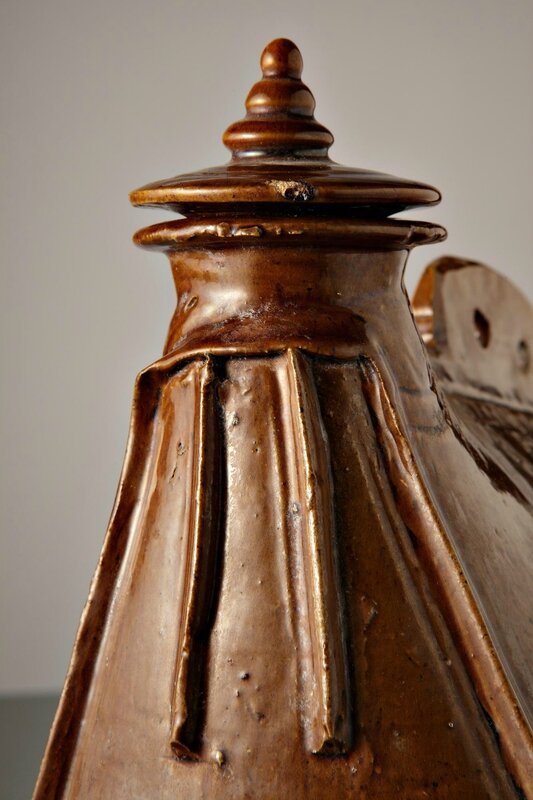Pilgrims Flask, China, Liao Dynasty (907-1125)
Pilgrims Flask, China, Liao Dynasty (907-1125). Photo courtesy Vanderven Oriental Art.
Height: 24,5 cm.
Featuring a strap hole and a lid, the form of this vessel - also known as cockscomb pot, jiguanhu 鸡冠壶, or horse-stirrup pot, madenghu 马镫壶.. The shape originates from the leather satchel-like containers employed by early Qidan people to carry liquids such as water, milk and wine. This form appears to have originated in present-day Chifeng, Inner Mongolia, as early as the fourth century and has been excavated mainly from graves belonging to members of the Qidan aristocracy. The simulated holes for attachment of a carrying strap and the raised stitched-like decoration and rivets, such as can be discerned on this vessel, are typical features occurring on the earliest ceramic versions of this form. With time, a variant form of the bottle, featuring a loop-handles, and thus more appropriate for a settled life, evolved from the primitive form, thus reflecting the increasing adoption of a sedentary life on behalf of the Qidan, following their contacts with their Han Chinese neighbours.
Comparable examples of cockscomb bottles have been unearthed from high-ranking tombs in Liaoning and Inner Mongolia and can also be found in notable Chinese collections such as the Mengdiexuan, Xiwenguo Zhai and Jiurutang (Hong Kong); and in western collections such as the Meiyintang Collection Rietberg Museum (Zurich) and the Avery Brudage Collection (San Francisco).
Vanderven Oriental Art. MasterArt at TEFAF 2014 on stand 814. 14-23 march 2014 - http://www.masterart.com/

/https%3A%2F%2Fprofilepics.canalblog.com%2Fprofilepics%2F1%2F0%2F100183.jpg)
/https%3A%2F%2Fstorage.canalblog.com%2F03%2F02%2F119589%2F96711876_o.jpg)
/https%3A%2F%2Fstorage.canalblog.com%2F11%2F31%2F119589%2F94773502_o.jpg)
/https%3A%2F%2Fstorage.canalblog.com%2F20%2F83%2F119589%2F94772815_o.jpg)
/https%3A%2F%2Fstorage.canalblog.com%2F26%2F72%2F119589%2F75604929_o.jpg)
/https%3A%2F%2Fstorage.canalblog.com%2F59%2F60%2F119589%2F26458628_o.jpg)




/http%3A%2F%2Fstorage.canalblog.com%2F05%2F64%2F119589%2F128523518_o.jpg)
/http%3A%2F%2Fstorage.canalblog.com%2F78%2F46%2F119589%2F127133605_o.jpg)
/http%3A%2F%2Fstorage.canalblog.com%2F99%2F82%2F119589%2F126892955_o.jpg)
/http%3A%2F%2Fstorage.canalblog.com%2F51%2F84%2F119589%2F122518624_o.jpg)